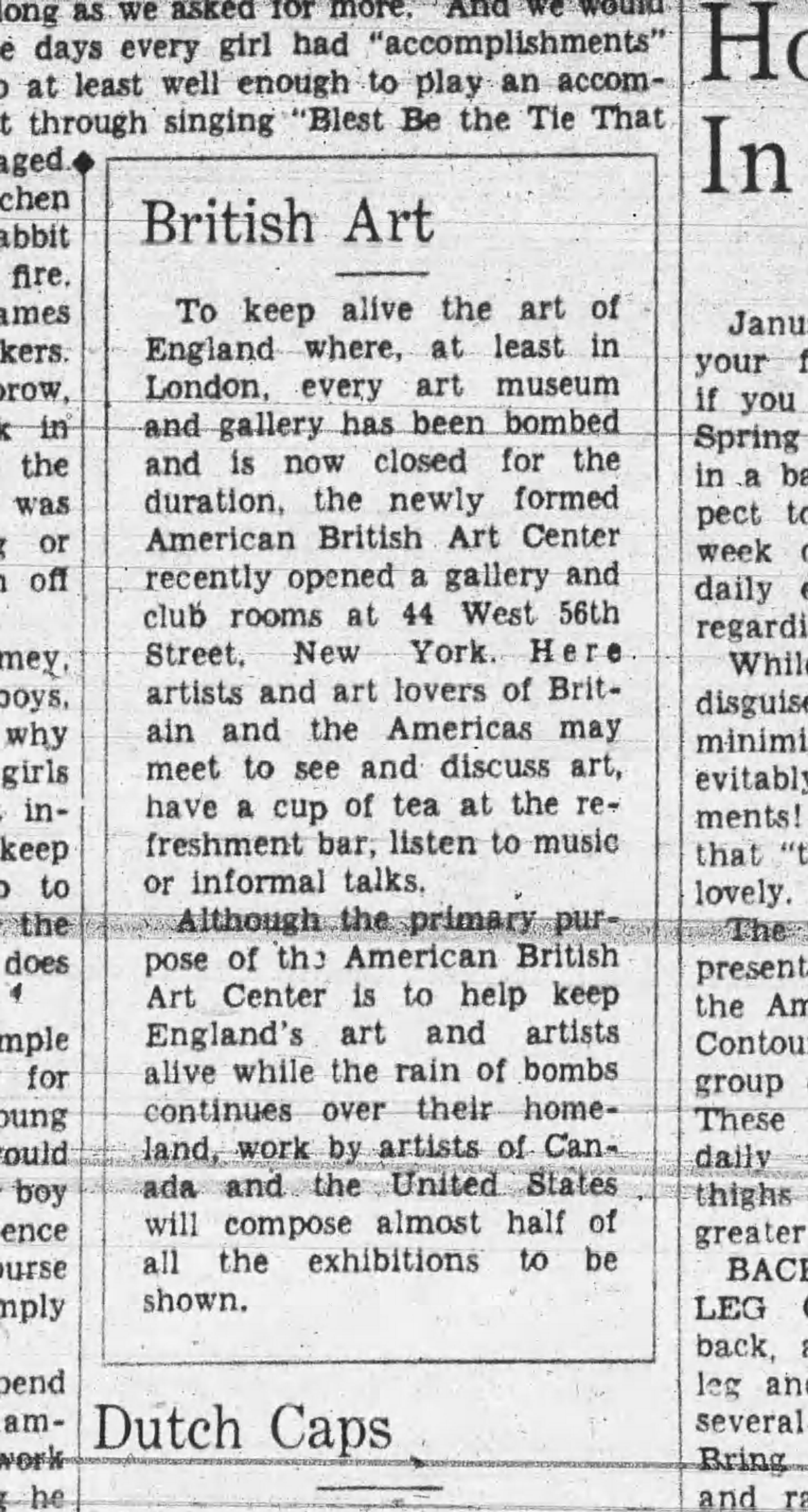Archive
American-British Art Center
- American-British Art Center
- Art Center
The émigré gallerist Ala Story left London for New York around 1940, where she co-founded the American-British Art Center, which introduced British and US artists to the public.
Word Count: 27
44 West 56th Street, Diamond District, New York City.

Article on the opening of the American British Art Center, 44 West 56th Street in New York in The Herald Statesman, 28 January 1941, p. 8 (Photo: Private Archive). 
Article on “Art Exhibit At Bar Harbor. Recent Photographs of Bombed London By Cecil Beaton” in The Bangor Daily News, 11 August 1941, p. 10 (Photo: Private Archive). The article describes the activities of the American British Art Center founded by Ala Story for the benefit of the London art scene, which was isolated and shaken by the war. Anonymous. “British Art.” The Herald Statesman, 28 January 1941a, p. 8.
Anonymous. “Art Exhibit At Bar Harbor. Recent Photographs of Bombed London By Cecil Beaton.” The Bangor Daily News, 11 August 1941b, p. 10.
Anonymous. “Mrs. Ala Story, Was Director of Museum of Art.” The Berkshire Eagle (Pittsfield, Mass.), 7 April 1972, p. 13.
Breton, Harriette Von. “Margaret Mallory and Ala Story Collections.” Artform International, March 1966, p. 18, www.artforum.com/print/reviews/196603/margaret-mallory-and-ala-story-collections-75317. Accessed 21 February 2021.
Brunner, Andreas. “Erica Anderson (1914–1976). Lesbische Netzwerke im Exil.” Lambda Nachrichten, vol. 39, no. 172, 2017, pp. 46–48, https://lambdanachrichten.at/ln175.pdf. Accessed 8 March 2021.
Brunner, Andreas. “Die queeren Netzwerke der Erica Anderson.” Doing Gender in Exile. Geschlechterverhältnisse, Konstruktionen und Netzwerke in Bewegung, edited by Irene Messinger and Katharina Prager, Westfälisches Dampfboot, 2019, pp. 142–155.
Gordon, Jan. “Art and Artists.” The Observer, 19 November 1939, p. 8.
Hedley, Gill. “Three female gallerists who changed the course of British art.” 29 September 2016, Royal Academy of Arts, www.royalacademy.org.uk/article/movers-and-shakers-female-gallerists-british-art. Accessed 27 January 2021.
Niederacher, Sonja. “Dossier zu Egon Schiele Deuring-Schlösschen, 1912, Leopold Museum Privatstiftung LM Inv. Nr. 2373.” 31 December 2014, docplayer, http://docplayer.org/66704325-Dossier-egon-schiele-deuring-schloesschen-1912.html. Accessed 21 February 2021.
Private Wire. “Our London Correspondence.” The Manchester Guardian, 30 September 1939, p. 8.
Story, Ala. Impressionism and its influence in American Art, exh. cat. Santa Barbara Museum of Art, Santa Barbara, 1954.
Story, Ala. Paintings by Oskar Kokoschka, exh. cat. Santa Barbara Museum of Art, Santa Barbara, 1954.
Story, Ala. The First West Coast Retrospective Exhibition of Paintings by William Merritt Chase (1849–1916), exh. cat. Art Gallery, University of California, Santa Barbara, 1964.
Story, Ala. Paul Klee. Oils, Watercolors, Gouaches, Drawings, Prints from the James Gilvarry Collection, exh. cat. Art Gallery, University of California, Santa Barbara, 1967.
Story, Ala. First Comprehensive Retrospective Exhibition in the West of Oils, Gouaches. Pastels, Drawings and Graphic Works by Max Weber (1881–1961), exh. cat. Art Gallery, University of California, Santa Barbara, 1968.
Story, Ala. Constructive Tendencies, exh. cat. Art Gallery, University of California, Santa Barbara, 1970.
Story, Ala. Trends in Twentieth Century Art, exh. cat. Art Gallery, University of California, Santa Barbara, 1970.
Taylor, Brandon. Art for the Nation: Exhibitions and the London Public 1747–2001. Manchester University Press, 1999.
The Ala Story Collection of Art in the Santa Barbara Museum of Art, exh. cat. Santa Barbara Museum of Art, Santa Barbara, 1971.
Word Count: 358
Archives of American Art, Washington D.C., Ala Story papers (1941–1970).
Word Count: 10
- 1941
Ala Story.
- New York
- Burcu Dogramaci. "American-British Art Center." METROMOD Archive, 2021, https://archive.metromod.net/viewer.p/69/2948/object/5145-11267587, last modified: 16-12-2022.
-
Ruth BernhardPhotographerNew York
Ruth Bernhard was a German émigré photographer who lived in New York from the 1920s to the 1940s. Beside her series on female nudes, her place in the photography network, as well as in the New York queer scene, is unknown and understudied.
Word Count: 43
Ala StoryGalleristCuratorArt CollectorMuseums DirectorLondonOriginally from Vienna, Ala Story worked for galleries such as Redfern and Storran, opened the Stafford Gallery in 1938 and developed it into the British Art Centre.
Word Count: 26
Norlyst GalleryGalleryArt GalleryNew YorkFounded in 1943 by the American painter and art collector Elenore Lust, the Norlyst Gallery represented a cross section of contemporary painting, photography and other media focusing on surrealist and abstract expressionist styles and promoting women artists and photographers.
Word Count: 38
Weyhe GalleryArt GalleryNew YorkOpened in 1919 by the German-born art dealer Erhard Weyhe opened a bookstore and gallery space specialised in contemporary European artists and was the first to specialise in prints.
Word Count: 28
Julien Levy GalleryArt GalleryNew YorkThe Julien Levy Gallery was founded by the art dealer Julien Levy (1906–1981) in 1931, and was situated in the New York gallery district around 57th Street, where the Weyhe and Norlyst Gallery were also located.
Word Count: 34